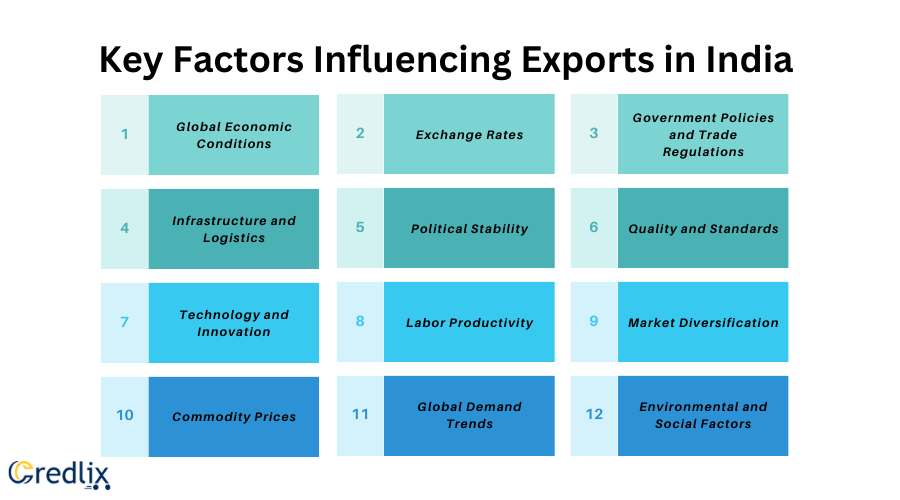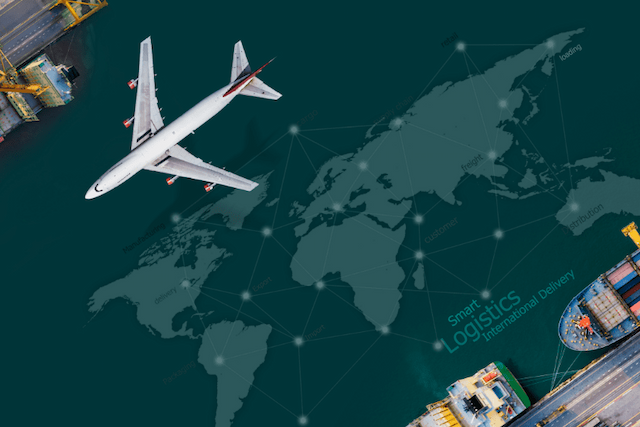India’s leading exports comprise petroleum products, gems, jewelry, and iron and steel. Remarkably, the export value of petroleum products surpassed 39 billion U.S. dollars.
India’s export performance is influenced by a myriad of interconnected factors. Global economic conditions play a pivotal role, impacting demand for Indian goods and services. Exchange rate fluctuations can affect competitiveness, with a weaker currency making exports attractive. Government policies and trade regulations, when supportive, boost the export sector through incentives and reduced barriers.
The efficiency of infrastructure and logistics impacts cost and speed of exports, while political stability is vital to foster a favorable business environment. Adherence to international quality standards enhances the reputation of Indian products. Technological advancements and innovation contribute to global competitiveness. Labor productivity, market diversification, and sensitivity to commodity prices are critical considerations.
Additionally, aligning with evolving global demand trends and embracing environmental and social sustainability further enhance India’s position in the global export landscape. A nuanced understanding of these factors is essential for policymakers and businesses seeking to navigate the complex dynamics of international trade.
Key Factors Influencing Exports in India

Several factors can influence exports in India. These factors are often interconnected and can impact the country’s ability to sell goods and services internationally. Here are some key factors:
Global Economic Conditions
The overall state of the global economy can significantly impact India’s export performance. During periods of global economic downturns, demand for goods and services may decrease, affecting India’s export volumes.
Example: Imagine a global economic downturn hits, causing consumers worldwide to tighten their belts. In this scenario, the demand for Indian goods and services dwindles as international buyers cut spending. For instance, the Indian textile industry might experience a slump in orders, impacting export volumes. Similarly, reduced global IT spending during economic downturns can affect India’s IT service exports.
The overall decrease in demand, coupled with currency fluctuations and supply chain disruptions, exemplifies how interconnected global economic conditions directly influence India’s export performance, showcasing the vulnerability of export-oriented sectors during challenging economic times.
Exchange Rates
Fluctuations in exchange rates can impact the competitiveness of Indian exports. A weaker Indian currency can make exports more attractive to foreign buyers, while a stronger currency may make exports more expensive.
Example: Consider a scenario where the Indian Rupee weakens against major global currencies. Let’s say, initially, 1 USD equals 70 INR. If the Rupee weakens, and now 1 USD equals 75 INR, Indian goods become more affordable for foreign buyers in dollar terms. This could boost demand for Indian exports like textiles or software services. Conversely, if the Rupee strengthens, making 1 USD equal to 65 INR, Indian exports become more expensive for foreign buyers.
This can lead to a decline in export competitiveness, affecting industries reliant on international markets. Exchange rate fluctuations thus play a pivotal role in shaping India’s export dynamics.
Government Policies and Trade Regulations
Government policies, trade agreements, and regulations play a crucial role. Policies that support exports, reduce trade barriers, and provide incentives can boost the export sector.
Example: Imagine the Indian government implements a policy offering tax incentives and subsidies to promote the export of renewable energy technologies. By doing so, they aim to bolster the country’s position in the global clean energy market. These incentives can reduce production costs for Indian companies, making their products more competitively priced in the international market.
Additionally, the government might negotiate favorable trade agreements with key partners, further facilitating the export process. Such strategic policies and regulations demonstrate how a supportive government approach can significantly enhance the export sector, fostering economic growth and global competitiveness for specific industries.
Infrastructure and Logistics
The efficiency of transportation, logistics, and other infrastructure elements can affect the cost and speed of exporting goods. Improvements in infrastructure can enhance the competitiveness of Indian exports.
Example: Consider a scenario where India invests significantly in upgrading its port facilities and transportation networks. With improved infrastructure, the time it takes to transport goods from manufacturing hubs to ports decreases, and the overall logistics become more efficient. This results in a substantial reduction in shipping costs and faster delivery times for exported products.
For instance, a textile manufacturer in Gujarat can now seamlessly transport its goods to an upgraded port in Mumbai, reducing transit times and costs. Such investments in infrastructure not only benefit exporters but also enhance the overall competitiveness of Indian products in the global market.
Political Stability
Political stability in both India and its trading partners is essential for fostering a favorable business environment. Political uncertainties and conflicts can disrupt trade relations.
Example: Imagine a situation where political instability arises in one of India’s key trading partners, affecting trade relations. For instance, if there’s political unrest in a major European market, it could lead to uncertainties about the future business environment. Indian exporters may face delays, payment issues, or even disruptions in supply chains due to the unstable political conditions.
Conversely, in times of political stability, trade flows smoothly, and businesses can confidently engage in long-term agreements. This example underscores how political stability, both in India and its trading partners, is crucial for sustaining a favorable and predictable climate for international trade.
Quality and Standards
Meeting international quality standards is crucial for gaining acceptance in global markets. The adherence to quality norms and certification can enhance the reputation of Indian products abroad.
Example: Consider an Indian electronics manufacturer that invests in stringent quality control measures to meet global standards. By ensuring that its products comply with international quality benchmarks, the company gains a reputation for reliability and excellence. When a consumer in another country purchases a smartphone or electronic gadget made by this Indian manufacturer, they can trust that the product meets high-quality standards.
This commitment to quality not only enhances customer satisfaction but also contributes to building a positive perception of Indian products in the global market, ultimately fostering increased demand and competitiveness for Indian exports in the electronics industry.
Technology and Innovation
Embracing technological advancements and fostering innovation can improve the competitiveness of Indian exports. Products and services that incorporate cutting-edge technology may have an advantage in the global market.
Example: Imagine an Indian pharmaceutical company that invests in innovative research and development to create advanced drug formulations. By leveraging cutting-edge technology, they develop medicines with enhanced efficacy and fewer side effects. When these innovative pharmaceuticals hit the global market, they gain a competitive edge over traditional offerings. International consumers, recognizing the value of these technologically advanced products, are more inclined to choose them over alternatives. This example highlights how embracing technology and fostering innovation can not only elevate the competitiveness of Indian exports but also contribute to advancements that address global needs and preferences.
Labor Productivity
The productivity of the labor force influences the cost of production. Higher productivity can lead to cost advantages, making Indian exports more competitive in the global market.
Example: Consider a scenario in the textile industry where an Indian manufacturer adopts advanced machinery and provides specialized training to its workforce. As a result, the labor force becomes highly skilled and efficient, leading to increased productivity. With faster production processes and lower error rates, the cost of manufacturing per unit decreases.
This allows the company to offer competitive pricing for its textile products in the global market. Higher labor productivity not only contributes to cost advantages but also positions Indian exports favorably against competitors, showcasing how an efficient and skilled labor force enhances the competitiveness of products in the international market.
Market Diversification
Diversifying export markets helps mitigate risks associated with dependence on a particular region. Exploring new markets can provide opportunities for growth and reduce vulnerability to economic downturns in specific regions.
Example: Imagine an Indian automobile manufacturer traditionally reliant on European markets for a significant portion of its exports. Sensing the need to diversify and reduce vulnerability to economic fluctuations, the company strategically expands its reach to emerging markets in Southeast Asia and South America. By tapping into new regions, the manufacturer not only reduces its dependency on a single market but also discovers untapped opportunities for growth.
When economic challenges hit Europe, the diversified market approach helps the company maintain a more stable revenue stream. This example illustrates how market diversification can act as a risk mitigation strategy and provide avenues for sustained export growth.
Commodity Prices
The prices of commodities, especially those that are major exports for India (such as agricultural products, minerals, and textiles), can impact export revenues.
Example: Consider a scenario where India is a major exporter of rice. If global commodity prices for rice experience a significant decline due to factors like oversupply or changes in demand, Indian rice exporters may face lower export revenues. The reduced prices affect the overall income generated from rice exports, impacting the profitability of Indian farmers and the rice industry.
Conversely, if there’s a surge in global demand or a supply shortage, leading to increased commodity prices, Indian rice exporters stand to benefit with higher export revenues. This example illustrates how fluctuations in global commodity prices directly influence the export earnings of countries heavily reliant on specific commodities.
Global Demand Trends
Changes in global consumer preferences and demand trends can affect the competitiveness of Indian exports. Adapting to emerging trends and identifying new market opportunities is crucial.
Example: Consider the technology sector where India is a major player. In response to the growing global demand for sustainable and eco-friendly products, an Indian IT company shifts its focus to develop software solutions that prioritize energy efficiency and environmental sustainability.
By adapting to emerging global trends, the company not only aligns itself with the changing preferences of international consumers but also gains a competitive edge in the market. This example demonstrates how staying attuned to global demand trends and proactively adjusting product offerings can enhance the competitiveness of Indian exports in dynamic and evolving international markets.
Environmental and Social Factors
Increasing awareness of environmental and social sustainability can influence consumer preferences and trade policies. Adherence to sustainable practices can enhance the marketability of Indian products.
Example: Imagine an Indian textile manufacturer that adopts eco-friendly production practices and ensures fair labor conditions. This commitment to environmental and social sustainability aligns with the growing global consciousness around ethical consumerism. Consequently, international buyers, especially in environmentally conscious markets like Europe, are more inclined to choose products that adhere to sustainable standards.
The Indian textiles, manufactured with a focus on reducing environmental impact and promoting fair labor, gain a competitive advantage in these markets. This example illustrates how incorporating environmental and social factors into production practices enhances the marketability of Indian products, appealing to the values and preferences of socially responsible consumers worldwide.
Conclusion
India’s export success is a complex interplay of factors. From global economic conditions to technological innovation and adherence to quality standards, each aspect shapes the nation’s competitiveness. By embracing market diversification, recognizing global demand trends, and prioritizing environmental and social sustainability, India positions itself for sustained growth.
A skilled labor force and supportive government policies further contribute to the nation’s export prowess. Navigating this intricate landscape requires a nuanced understanding and adaptability. As India continues to evolve, its ability to address these factors will determine its success in the dynamic and competitive realm of international trade.
Also Read: Types of Export Factoring




